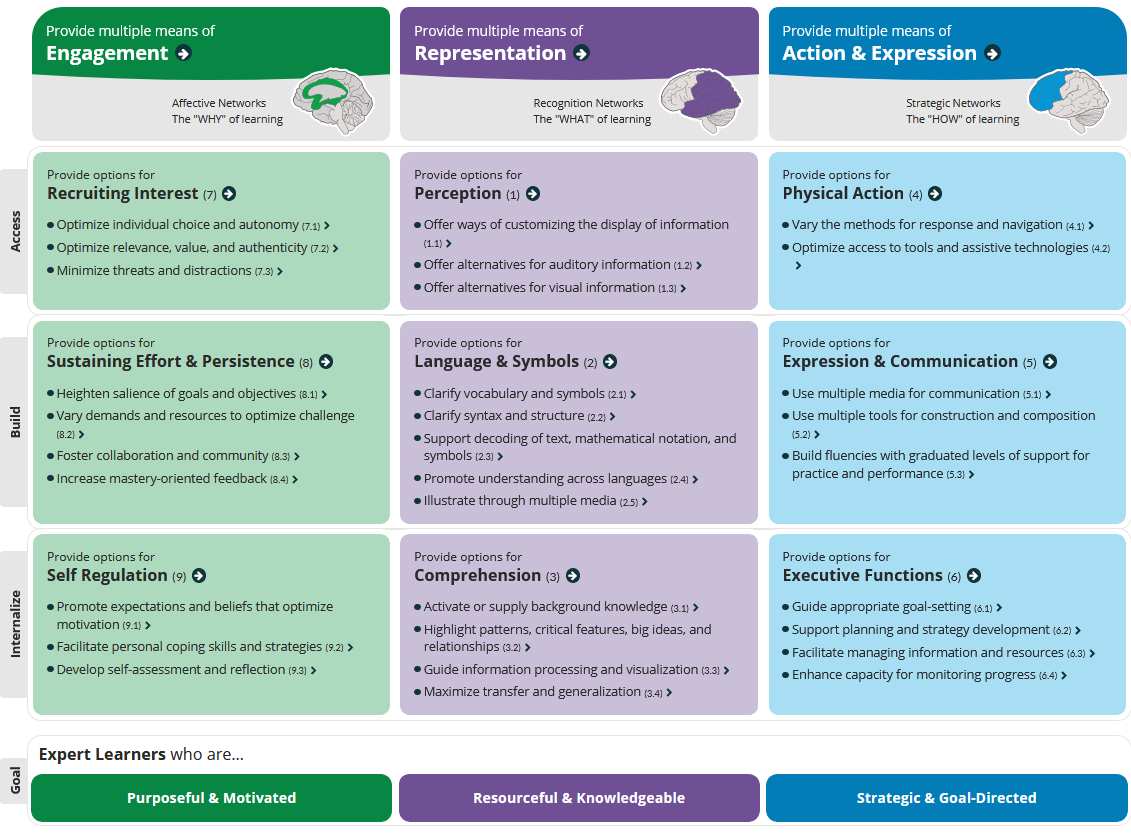Universal Design for Learning
Published on
As we've learned in Accessibility Principles for ICT, we can apply universal design to fields outside of architecture and web products. CAST, a nonprofit education research and development organization, built up the field of Universal Design for Learning (UDL). UDL is a educational framework of principles, guidelines, and checkpoints that works towards one goal: create expert learners who are:
- purposeful,
- motivated,
- resourceful,
- knowledgeable,
- strategic, and
- goal-directed.
What are the principles of universal design for learning?
Permalink for "What are the principles of universal design for learning?"There are 3 principles of UDL. Each principle has 3 guidelines. Each guideline has a list of checkpoints.
- Provide multiple means of representation: Recognition Networks, the "What" of learning.
- Perception:
- Offer ways of customizing the display of information.
- Offer alternatives for auditory information.
- Offer alternatives for visual information.
- Language & symbols:
- Clarify vocabulary and symbols.
- Clarify syntax and structure.
- Support decoding of text, mathematical notation, and symbols.
- Promote understanding across languages.
- Illustrate through multiple media.
- Comprehension:
- Activate or supply background knowledge.
- Highlight patterns, critical features, big ideas, and relationships.
- Guide information processing and visualization.
- Maximize transfer and generalization.
- Perception:
- Provide multiple means of action and expression: Strategic Networks, the "How" of learning.
- Physical action:
- Vary the methods for response and navigation.
- Optimize access to tools and assistive technologies.
- Expression & communication:
- Use multiple media for communication.
- Use multiple tools for construction and composition.
- Build fluencies with graduated levels of support for practice and performance.
- Executive function:
- Guide appropriate goal-setting.
- Support planning and strategy development.
- Facilitate managing information and resources.
- Enhance capacity for monitoring progress.
- Physical action:
- Provide multiple means of engagement: Affective Networks, the "Why" of learning.
- Recruiting interest:
- Optimize individual choice and anatomy.
- Optimize relevance, value, and authenticity.
- Minimize threats and distractions.
- Sustaining effort & persistence:
- Heighten salience of goals and objectives.
- Vary demands and resources to optimize challenge.
- Foster collaboration and community.
- Increase mastery-oriented feedback.
- Self regulation:
- Promote expectations and beliefs that optimize motivation.
- Facilitate personal coping skills and strategies.
- Develop self-assessment and reflections.
- Recruiting interest:
The UDL principles, guidelines, and checkpoints can be easier to digest as a 3x3 matrix that CAST presents on its website:

The UDL Guidelines matrix on the CAST website.
Conclusion
Permalink for "Conclusion"UDL puts a lot of focus on including learners with disabilities. In doing so, UDL acknowledges that by including people with disabilities, curriculum will naturally include more students by accepting each student's own learning style, communication mode, and motivational carrot. Learning becomes more about strengthening learning techniques, and less about the thing learned or the rigid metrics desired by some educational systems. It's people-first.